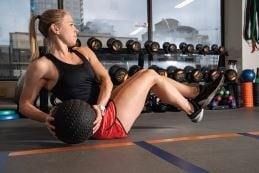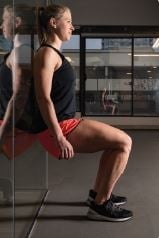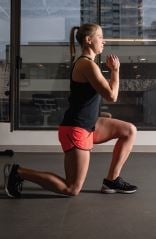
Learn how creating your own strength practice can improve your self-image and why the trendy phrase “strong is the new skinny” might not be serving us well. Try our strength workout with a friend!
It’s a familiar phrase among female fitness enthusiasts. You’ve likely noticed it creeping into discussions at the gym, in posts on fitness-focused social media accounts, or displayed on women’s workout tops. It’s a positive change— a productive development for women’s body image, right?
Not so fast.
“Strong is the new skinny” is certainly moving in the right direction, and in theory, the concept is great. In practice, however, it’s used in ways that are not always conducive to creating a healthy body image.
Typically, this phrase is a caption on an image depicting a well-muscled, scantily clad model with six-pack abs and an extremely low body fat percentage. Most of the time, the model isn’t doing anything other than posing. Strong women with a variety of body types, performing actual feats of strength, are rarely shown.
We’re now replacing one cultural ideal (“skinny”) with another (muscled and lean). The way the phrase is used still focuses exclusively on aesthetics. It’s essentially saying, “Muscles are the new skinny.”
Some women are naturally lean. Some women gain muscle more easily than others. Athletes exist across a full range of body fat percentages. Strong doesn’t have a “look.” Of course, we all want to look and feel amazing. But “amazing” comes in many different shapes and sizes and abilities, and is not exclusive to the muscled-and-lean look.
There’s no one-size-fits-all definition of “strong.”
Strength could mean bench pressing with a barbell for the first time. It could be performing unassisted pull-ups, mastering technical movements with kettlebells, or deadlifting your body weight for reps. Or it could be keeping up with your kids at the playground and having the ability to do the daily activities you enjoy without fear of injury.
Your body image can improve greatly when you create your own strength training practice. Female clients often start working with me because they’re unhappy with how they look. Their sole motivation at the gym is to change their physiques.
Once they start strength training regularly and realize what their bodies can do, they continue training not because they’re unhappy with how they look, but because they’re amazed at what they can do. Training for performance-based goals will most likely have an effect on your physique, anyway! How’s that for a win-win?
As you work on developing your strength practice, don’t forget the importance of nutrition in fuelling your fitness goals. Focus on a variety of whole foods such as veggies, fruits, whole grains, legumes, seeds, and nuts.
Fitness tips to foster a healthy body image
- Try not to compare yourself to others. Focus on your own strength practice, on how your body feels, and what it can do.
- Do what makes you feel good. There’s no rule that says you need to lift weights in a gym. Foster strength in a way that works for you, such as rock climbing, yoga, outdoor boot camps, or dragon boating.
- Find a training buddy who views fitness as a positive pursuit in her life. The attitudes of the people with whom we spend time (perhaps especially when we’re working out) rub off on us!
PROTEIN POWER
If you strength train regularly, the Academy of Nutrition and Dietetics, the American College of Sports Medicine, and the Dietitians of Canada recommend 1.2 to 2 g of protein per kilogram of body weight per day to effectively recover from training and to promote the growth and maintenance of muscle.
If you’re in a caloric deficit to lose weight, you may need more than this protein amount to prevent losing muscle along with fat. Some healthy high-protein foods include tempeh, seitan, tofu, dry roasted edamame, nutritional yeast, black bean or red lentil pasta, and hempseeds.
STRENGTH IN NUMBERS
The scale is not an accurate measure of most women’s fitness levels. In many cases, as strength level increases, so does the number on the scale. If a client’s waist measurement is staying the same or decreasing, and her body weight is increasing, I see that as an excellent sign of having built muscle.
STRENGTH WORKOUT
Complete as a circuit. Aim for three rounds of the circuit, performing 15 reps of each move (per side, where applicable). For resistance band sprints, aim for 20 seconds each round.
MED BALL MOUNTAIN CLIMBER
Muscles targeted: abs and shoulders


This move improves core and shoulder stability. Both are important for injury prevention!
- Start in a plank position with your hands on a medicine ball (fingers pointing toward the floor).
- Bring one knee toward your chest. Hold for a second, then bring your leg back to the start position and repeat on the other side.
MED BALL RUSSIAN TWIST
Muscles targeted: abs


Fire up your entire core musculature, focusing on your obliques.
- Sit on the floor with your knees bent, feet off the floor, leaning back slightly. Hold a medicine ball at waist level.
- Lightly touch the ball to the floor next to your right hip, then repeat on the left.
MED BALL PUSH-UPS
Muscles targeted: triceps, chest, shoulders


A challenging push-up variation that improves your strength and balance.
To practise this move, perform negative reps: start in the top position and lower yourself slowly (3 to 4 seconds). Then start back at the top.
- Start in a plank position with your hands on a medicine ball (fingers pointing toward the floor).
- Inhale and bend your arms, bringing your chest to the ball. Exhale as you push yourself away from the ball and back to the start position.
RESISTANCE BAND SPRINTS
Muscles targeted: quads, hamstrings, glutes

You and your training buddy will strengthen all the muscles in the lower body while improving cardiovascular conditioning!
- Stand with a large, flat resistance band (pull-up assist bands work well) around your hips, with your training partner holding the band behind you.
- Lean forward and sprint as fast as you can, while your partner leans back and provides resistance, following behind you. After your set, switch places.
PLANK HIGH-FIVES
Muscles targeted: abs and shoulders

A classic partner exercise that strengthens your core and shoulders.
- You and your partner start facing each other in a plank position, with your heads about a foot apart.
- Lift your left hands and give each other a high-five about a foot off the floor. Place your hands back on the floor and repeat on the right.
WALL SQUAT + WALKING LUNGES
Muscles targeted: quads, hamstrings, glutes


- Press your back against a wall or other stable object. Lower yourself into a squat so your knees are bent at 90 degrees.
- While you hold the wall squat, your workout buddy performs walking lunges, taking a step forward and bending both knees so that her back knee almost touches the floor.
- Once she’s completed 15 reps per leg, switch places.
Karina Inkster, MA, PTS, is a health and fitness coach, author of two books, and speaker. Her award-winning online programs help vegans worldwide live their healthiest, most plant-strong lives.
ATHLETE: Shannon Payeur, @runshannyrun
LOCATION: Qubecore Sports & Rehab, qubecore.com


